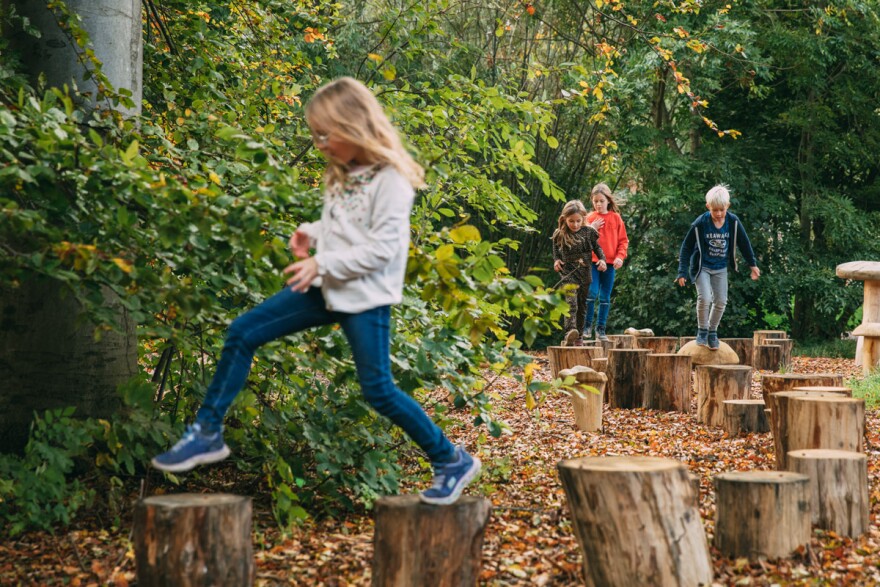Last month, Unit 5 Superintendent Kristen Weikle made an intriguing announcement: The school district had been gifted $5 million to build a sprawling “natural playground” at Colene Hoose elementary school.
At the time, Weikle said she expected the playground to be unlike anything that exists in the U.S.
The donation came from Charlie Jobson, a former Hoose student, who offered the gift in honor of his parents. Jobson said the project was inspired by his parents’ love of nature, and playgrounds he discovered on a recent family trip to Scandinavia.
Jobson hopes the Hoose playground can be a “reference project for the rest of the country.”
In addition to the money, Jobson presented Unit 5 with what he called a “dream team” of international experts to lead the project. Construction is expected to run from August through October at the school, 600 Grandview Drive, Normal. Once completed, the Hoose natural playground won’t feature any components of a traditional playground — no swings, no monkey bars, no twisting plastic slides.

Instead, the environment will comprise natural elements like boulders, logs, and creeks that invite kids to figure their way over, around, and across.
Tim Gill, a scholar and advocate for child-friendly design, said it’s essential that kids be given the chance to interact with the unexpected.
“Children need to gain a sense of kind of how they can kind of deal with and cope with navigating, literally and figuratively, a world where not everything is predictable and there won’t be someone next to them who can fend away any possible sources of harm,” Gill said.
Handpicked by Jobson to help design the Hoose playground, Gill has long argued that we’ve gone too far in our efforts to protect kids from harm. He wrote a 2007 book about the negative effects of an overprotective culture called "No Fear: Growing Up in a Risk Averse Society."
The word risk may carry unduly frightening connotations, Gill said. It’s not about intentionally exposing children to danger, but rather allowing them to become confident in their ability to figure out things on their own.
“Risk is really about uncertainty. And living and thriving in a world where nothing is totally predictable, and never has been,” Gill said.
Traditional playgrounds, with equipment that allows kids to jump and climb, may give the perception of risk. But standardized design means that at their core, most playgrounds are pretty much the same. And so for kids, the environments quickly become predictable.
Keeping the brain engaged
Adam Bienenstock, the founder of a natural playground company in Ontario, Canada is leading construction on the Hoose project. He said the kind of predictability bred on traditional playground leads to the wrong kind of risk.
Bienenstock said kids tend to use a standard piece of equipment, like monkey bars, only a few times before forming muscle memory. Once that happens, kids tend to “switch of the brain,” he said, and start operating on a kind of autopilot.
“That’s not the way we want our kids to play,” Bienenstock said. “They’re safest when their brains are in.”
He said kids are naturally wired for risk assessment, but once an activity becomes rote, that part of their brain switches off. That’s when a kid will start trying to introduce manufactured risk into a situation to make it more interesting.
"Children need to gain a sense of kind of how they can kind of deal with and cope with navigating, literally and figuratively, a world where not everything is predictable."Tim Gill
A kid who’s mastered the monkey bars will start doing “stupid stuff,” Bienenstock said, like walking across the top of the equipment, or trying to traverse it upside down — choices driven by boredom that can easily lead to injury.
But the risks of traditional playgrounds go beyond physical injury, said Bienenstock, explaining that standard playground equipment encourages play through strength and gross motor skills. That kind of design works well for some kids, he said, but it leaves many others feeling left out or left behind.
Bienenstock said the design of a natural playground seeks to incorporate ways to “pick up all those forgotten kids, which are the majority of them, and give them a place of mastery."
That’s where Helle Nebelong comes in.
Based in Copenhagen, Denmark, Nebelong is regarded as a pioneer in nature play. For the past 30 years, she’s designed playgrounds and sensory gardens throughout Europe. The Hoose playground will be her first project in the U.S.
Nebelong said play should be accessible to all children, and that playgrounds should bring kids together rather than segregating them based on ability.
Nebelong calls this concept universal design — building something that can be used by equally by all rather than designing certain elements for certain people.
Nebelong said this is especially meaningful for children with disabilities.
“They want to play like all other children. And they want to play in the same way. They don’t want structures that are special designed for them so that everyone can see that they are somehow different than others,” she said.
Nebelong said that every part of the Hoose playground was designed for all kids to use — even the snake-shaped “mound” that will overlook the land.
Because everyone, she said, should know the feeling of being on top.


